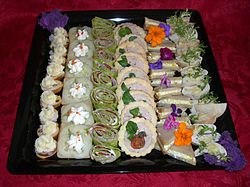CANape

Tray of canapés
|
|
| Course | Hors d'oeuvre |
|---|---|
| Place of origin | France |
| Main ingredients | Base: one of crackers, bread, toast or puff pastry Topping: savoury butters, spreads, or pastes |
| Variations | Amuse-bouche, vol-au-vent |
| |
|
A canapé is a type of hors d’œuvre (“outside the (main) work”), a small, prepared and usually decorative food, consisting of a small piece of bread (sometimes toasted) or puff pastry or a cracker topped with some savoury food, held in the fingers and often eaten in one bite.
The name comes from the French word for sofa, drawing on the analogy that the garnish sits atop the bread as people do a couch.
Because they are often served during cocktail hours, it is often desired that a canapé be either salty or spicy, in order to encourage guests to drink more. A canapé may also be referred to as finger food, although not all finger foods are canapés. Crackers or small slices of bread or toast or puff pastry, cut into various shapes, serve as the base for savory butters or pastes, often topped with a “canopy” of savory foods as meat, cheese, fish, caviar, foie gras, purées or relish.
Traditionally, canapés are built on stale bread (although other foods may be used as a base), cut in thin slices and then shaped with a cutter or knife. Shapes might include circles, rings, squares, strips or triangles. These pieces of bread are then prepared by deep frying, sautéing, or toasting. The foods are sometimes highly processed and decoratively applied (e.g., piped) to the base with a pastry bag. Decorative garnishes are then applied. The canapés are usually served on a canapé salver and eaten from small canapé plates. The technical composition of a canapé consists of a base (e.g., the bread or pancake), a spread, a main item, and a garnish. The spread is traditionally either a compound butter or a flavored cream cheese. Common garnishes can range from finely chopped vegetables, scallions, and herbs to caviar or truffle oil.
...
Wikipedia
